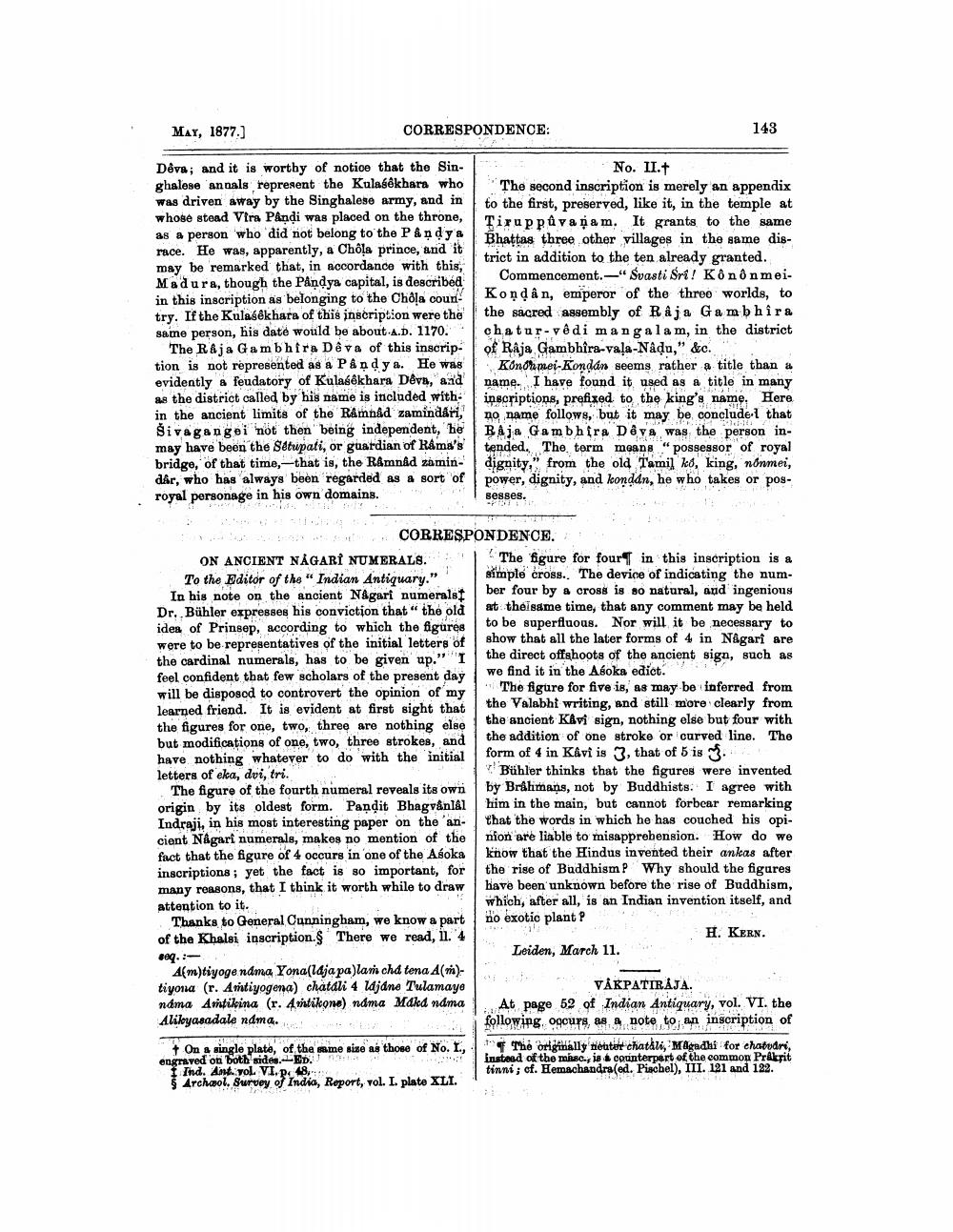________________
CORRESPONDENCE:
MAY, 1877.]
Dêva; and it is worthy of notice that the Singhalese annals represent the Kulasekhara who was driven away by the Singhalese army, and in whose stead Vira Pândi was placed on the throne, as a person who did not belong to the P &ndy a race. He was, apparently, a Chôla prince, and it may be remarked that, in accordance with this, Madura, though the Pandya capital, is described in this inscription as belonging to the Chôla coun try. If the Kulasekhara of this inscription were the same person, his date would be about A.D. 1170.
The R&ja Gambhira Deva of this inscription is not represented as a Pandya. He was evidently a feudatory of Kulasekhara Deva, and as the district called by his name is included with in the ancient limits of the Râmnâd zamindari, Sivagangei not then being independent, he may have been the Setupati, or guardian of Rama's bridge, of that time, that is, the Râmnâd zamindar, who has always been regarded as a sort of royal personage in his own domains.
ethodnog
CORRESPONDENCE.
ON ANCIENT NAGARI NUMERALS. To the Editor of the " Indian Antiquary." In his note on the ancient Nagari numeralst Dr. Bühler expresses his conviction that "the old idea of Prinsep, according to which the figures were to be representatives of the initial letters of the cardinal numerals, has to be given up." I feel confident that few scholars of the present day will be disposed to controvert the opinion of my learned friend. It is evident at first sight that the figures for one, two, three are nothing else but modifications of one, two, three strokes, and have nothing whatever to do with the initial letters of eka, dvi, tri.
The figure of the fourth numeral reveals its own origin by its oldest form. Pandit Bhagvanlâl Indraji, in his most interesting paper on the 'ancient Nagari numerals, makes no mention of the fact that the figure of 4 occurs in one of the Asoka inscriptions; yet the fact is so important, for many reasons, that I think it worth while to draw attention to it.
Thanks to General Cunningham, we know a part of the Khalsi inscription.§ There we read, 11. 4 seq.:
A(m)tiyoge náma Yona(lajapa)lam chá tena A(m)tiyona (r. Amtiyogena) chatáli 4 lajane Tulamaye náma Amtikina (r. 4mtikone) náma Máká náma Alikyasadale náma.
EV
On a single plate, of the same size as those of No. I., engraved on both sides.ED.
Ind. Ant. vol. VI. p. 48
Archaol. Survey of India, Report, vol. I. plate XLI.
143
No. II.†
The second inscription is merely an appendix to the first, preserved, like it, in the temple at Tiruppavanam. It grants to the same Bhattas three other villages in the same district in addition to the ten already granted.
Commencement.- -"Svasti Sri! KônônmeiKondân, emperor of the three worlds, to the sacred assembly of Raja Gambhira chatur-vêdi mangalam, in the district of Raja Gambhira-vala-Nadu," &c.
Kononmei-Kondán seems rather a title than a name. I have found it used as a title in many inscriptions, prefixed to the king's name. Here no name follows, but it may be conclude-l that Baja Gambhira Dêva was the person intended. The term means "6 possessor of royal dignity," from the old Tamil ko, king, nonmei, power, dignity, and konddn, he who takes or pos
48071
sesses.
The figure for four in this inscription is a simple cross.. The device of indicating the number four by a cross is so natural, and ingenious at the same time, that any comment may be held to be superfluous. Nor will it be necessary to show that all the later forms of 4 in Nagari are the direct offshoots of the ancient sign, such as we find it in the Asoka edict.
The figure for five is, as may be inferred from the Valabhi writing, and still more clearly from the ancient Kâvi sign, nothing else but four with the addition of one stroke or curved line. The form of 4 in Kavi is 3, that of 5 is ...
Bühler thinks that the figures were invented by Brahmans, not by Buddhists. I agree with him in the main, but cannot forbear remarking that the words in which he has couched his opinion are liable to misapprehension. How do we know that the Hindus invented their ankas after the rise of Buddhism? Why should the figures have been unknown before the rise of Buddhism, which, after all, is an Indian invention itself, and no exotic plant?
H. KERN.
Leiden, March 11.
VAKPATIRAJA.
At page 52 of Indian Antiquary, vol. VI. the following occurs, 88 sa note to an inscription of
The originally neuter chatali, Magadhi for chatvari, instead of the misc., is a counterpart of the common Prakrit tinni; of. Hemachandra(ed. Pischel), III. 121 and 122.




